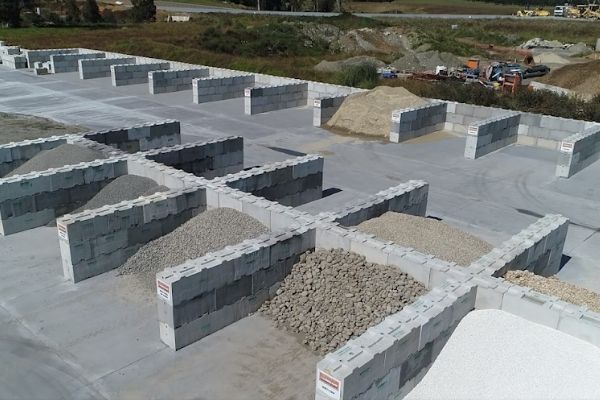The race to become sustainable can produce some perverse outcomes. Recycled Concrete Aggregates (RCAs) are the perfect example. It's an excellent way to reuse old buildings and footpaths. However, with the wrong initiatives, it can also increase waste and embed more carbon into concrete.
What are recycled concrete aggregates?
Another instance where RCAs are created is with excess wet concrete. If there is wet concrete leftover at a site, it is dumped, cured, and then crushed to form RCsS. RCAs are not common in New Zealand, however, there is an intent to make it so. Currently, the most common project uses of recycled concrete aggregate is within roading.
 (Cured concrete being crushed to form recycled concrete aggregate)
(Cured concrete being crushed to form recycled concrete aggregate)
Why RCA's are borderline sustainable
RCA's offer limited environmental benefits. The largest impact RCA's offer is the reduction in requirement for quarrying a finite resource - virgin aggregates. For the most part, virgin aggregate this is an abundant resource in New Zealand. This means that for our country, RCAs can be viewed as a simple cost trade-off compared to virgin aggregates (Infrastructure Resources Study, November 2021).
RCAs often require trucking crushed concrete longer distances, making initial carbon reduction unclear. High carbon belching machinery is then required to crush the aggregate. It then needs to be sorted, stored, and transported again.
Back in 1988, it was estimated that it takes 5 times the energy to produce RCAs compared to its virgin counterpart. The main difference between the two materials is labour. RCAs need resources/labour allocated to identify and remove materials like plastic, and glass. This process is not needed with virgin aggregates. In terms of transporting these two types of aggregates, it takes 3.8MJ for coarse & RCAs compared to 2.7MJ for fine aggregate (The Environmental Impact of Recycled Concrete, 2012). This is a difference of 1.1 MJs or a 40% difference in energy use.
An alternative solution to recycled concrete aggregates
Like most things in sustainability - there is no magic bullet. Different situations require different solutions. RCA's have their place in the reuse of old concrete post demolition.
However in an effort increase the use of RCA's some preverse practices end up becoming incentavised. Take wet excess concrete. This is the concrete left over at the end of the concrete pour.
In its wet state, the concrete is perfectly usable, and can be turned into high quality precast concrete products such as Interbloc. Jobs are created during the upcycling of the concrete, and the design of the block means it can be used over and over again.
Alternatively the excess concrete can be dumped on the ground, left for 28 days and then crushed for recycled concrete aggregate. In the process embedding every more carbon in the RCA to produce a physically inferior substitute product in a market with more supply than demand.
 (High-quality excess concrete being added to a Interbloc mould)
(High-quality excess concrete being added to a Interbloc mould)
Interbloc: Build Faster, Stronger, Safer
Interbloc is a precast concrete wall system with an innovative concrete block at its core. The system is made possible by our product stewardship scheme. We’ve partnered with some of New Zealand’s largest concrete companies to divert their excess wet concrete into the moulds that form Interbloc.
Instead of this high-quality excess being made into RCAs, it’s being used in our modular construction system. The modularity not only allows for fast installation, it means structures can be non-destructively dismantled and used for another project. This is a much more practical answer to sustainability.

Comparing recycled concrete aggregates to Interbloc
The production of Interbloc is efficient, but how does it compare to RCAs? Once the end of the construction phase is complete, Interbloc has 5 associated environmental impacts. RCAs on the other hand would have 10. The environmental impacts of these products are:
Interbloc
- CO 2 emissions from diesel consumption of transporting excess concrete to Envirocon’s yard.
- CO 2 emissions from diesel consumption of forklifts maneuvering within the yard.
- CO 2 emissions from diesel consumption of transporting Interbloc to construction sites.
- CO 2 emissions from diesel consumption of lifting cranes (or similar machinery) used for the assembly of Interbloc and heavy machinery used for excavation.
- A chemical release agent is used to facilitate releasing the blocks from their molds. Around 300 liters of chemical release agent is used per month.
RCAs
- CO 2 emissions from diesel consumption of transporting excess concrete to landfills.
- CO 2 emissions from diesel consumption of bulldozers (or similar machinery) used to demolish concrete into chunks
- CO 2 emissions from diesel consumption of transporting demolished concrete to quarries.
- CO 2 emissions from diesel consumption of machinery used to crush demolished concrete into the base course.
- CO 2 emissions from diesel consumption of transporting base course to construction sites.
- CO 2 emissions from diesel consumption of heavy vehicles used for laying and compacting base course.
- It is expected that the production of RCA in quarries will consume considerable amounts of water.
- As stated by S. B. MARINKOVIĆ and I. IGNJATOVIĆ (2013) [3], the recovery rate of demolished concrete is expected to be around 60%, which means 40% of the total concrete volume which will go to landfills.
- Crushing concrete in quarries is also expected to produce a considerable amount of dust.
- Dumping concrete in landfills requires dedicated spaces.
Interbloc uses less carbon, resources, and processes than RCAs.
To become truly sustainable, begin by using Interbloc.
Get in touch to start building









